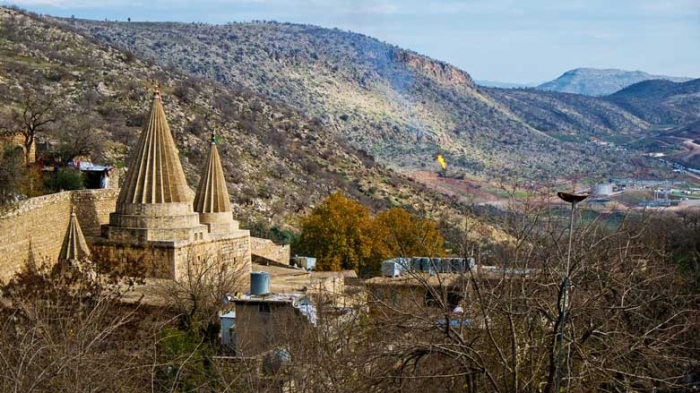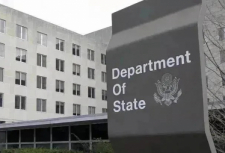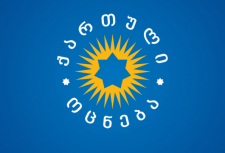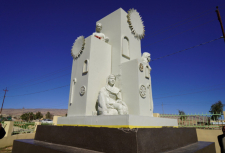Sacred Spaces in the Yazidi religion

Birgul Achiljyildiz
The author's work Birgula Achiljyildiz is a unique work on the study of the relationship between material culture and the contexts in which are formed the Yazidi sacred monuments. He sosredotochena attention on three main Yazidi settlements: Shahane, Sinjar and Benzene /Forehead-chic in Northern Iraq. The theme of the work is to discuss how form, content and function sanctify the place in the world of Yazidis. Among the questions that will be asked: what are the Yazidi monuments doing in the places where they were built? What makes a building "Yazidi", its shape, its function or its significance for Yazidis believers? In other words, how is the" spirit" of yazidism visually reproduced? Is there a connection between Islamic art and Yazidi funerary art? What is new Yazidi material culture?
In the Yazidis' world there is no tradition of communal prayer, or a temple to carry out their devotions. Thus, buildings were not purposely planned for religious practices and teaching. However, any such structures that do exist are, for the most part, all mausoleum, shrines for saints, and the houses of the men of religion (Sheikhs and Pirs) which, to a large extent, take the place of absent temples, though sometimes a stone, or a spring next to a plant will also fulfil the function of a place of worship. Despite their modest and rural appearance Yazidi mausoleum and shrines are an important part of the cultural environment of the Yazidi areas and constitute material signs of the general Yazidi belief system. In particular, the mausoleum denotes the presence of Yazidism and its unity, which are the most important hallmarks of the Yazidi settlements.
The Yazidi heartland lies, more precisely, in a triangle between Jazira, Amadiyya, and Mosul. This was a heterogeneous area where various religious, ethnic, and linguistic communities lived side by side, and it maintains its particularity today. Two distinctive Yazidi regions are well-known, namely Sheykhan and Sinjar, with the twin town of Behzane /Ba'shiqe between them. Although the Yazidi communities in these locations have a strong relationship between them, they have developed differently over the centuries and it is worth glancing briefly at each settlement to see the significance of each location for the Yazidi community and to examine the relationship between faith and buildings in each area.
Sheykhan, the administrative and spiritual center, is probably the most ancient homeland for the Yazidi community. Most of the important Yazidi villages such as Lalish, 'Eyn Sifnii, Ba'adre, and Bozan are located here. Lalish, which stands in a small valley, is regarded as holy in its entirety. Enclosed by mountains on three sides it has springs and streams ruining in every corner.
These irrigate many kinds of trees including those sacred to the Yazidis: the olive, the mulberry, and the grape vine. Maintained as a rural area, it is untouched by the modern world. Time seems to stand still here. As both countryside and architecture are together, considered to constitute an integral part of a sacred environment, each stone, plant, and building in this valley has a sacred meaning for Yazidi pilgrims. Thus, it is forbidden to cut down trees in Lalish, or to step with shod feet on its stones. Out of respect for nature, Yazidis remove their shoes on arrival in the valley. Even the Mounts of Hezıet,'Erefat, and Meshet, which encircle the valley, are regarded as sacred and have roles to play during the rituals and ceremonies. In Yazidi popular belief the mountain, the neighbor of the sky where God resides, is the meeting point of earth and sky, while Lalish, which houses the Sanctuary of Sheikh 'Adı, is the focal point of Yazidism. Moreover, with their modest appearance many mausoleum, shrines, caves, the baptistery of Kaniya Spi and the bridge of Silat are in harmony with the wild nature of the village. The bridge of Silat, located on a small stream that runs through the valley, is viewed as the bridge between this world and the hereafter, and has symbolic meaning for the faithful. Several ceremonies are performed on it at times of pilgrimage as well as during simple visits on Wednesdays, the holy day for Yazidis, when animals are sacrificed for the souls of the dead and the meat distributed' ln addition' more modem, small-scale dwellings for the needs of pilgrims are scattered on the lower slopes of the mountains' [n fact' apart from a group of religious people responsible for the upkeep of the sacred buildings, and who greet devotees, there is no permanent habitation in this valley as pilgrims reside here only during religious festivals' According to the Yazidis' God alone lives in this idyllic place.
Tags: #yazidisinfo #ezidi #yazidi
Sacred Spaces in the Yazidi religion

Birgul Achiljyildiz
The author's work Birgula Achiljyildiz is a unique work on the study of the relationship between material culture and the contexts in which are formed the Yazidi sacred monuments. He sosredotochena attention on three main Yazidi settlements: Shahane, Sinjar and Benzene /Forehead-chic in Northern Iraq. The theme of the work is to discuss how form, content and function sanctify the place in the world of Yazidis. Among the questions that will be asked: what are the Yazidi monuments doing in the places where they were built? What makes a building "Yazidi", its shape, its function or its significance for Yazidis believers? In other words, how is the" spirit" of yazidism visually reproduced? Is there a connection between Islamic art and Yazidi funerary art? What is new Yazidi material culture?
In the Yazidis' world there is no tradition of communal prayer, or a temple to carry out their devotions. Thus, buildings were not purposely planned for religious practices and teaching. However, any such structures that do exist are, for the most part, all mausoleum, shrines for saints, and the houses of the men of religion (Sheikhs and Pirs) which, to a large extent, take the place of absent temples, though sometimes a stone, or a spring next to a plant will also fulfil the function of a place of worship. Despite their modest and rural appearance Yazidi mausoleum and shrines are an important part of the cultural environment of the Yazidi areas and constitute material signs of the general Yazidi belief system. In particular, the mausoleum denotes the presence of Yazidism and its unity, which are the most important hallmarks of the Yazidi settlements.
The Yazidi heartland lies, more precisely, in a triangle between Jazira, Amadiyya, and Mosul. This was a heterogeneous area where various religious, ethnic, and linguistic communities lived side by side, and it maintains its particularity today. Two distinctive Yazidi regions are well-known, namely Sheykhan and Sinjar, with the twin town of Behzane /Ba'shiqe between them. Although the Yazidi communities in these locations have a strong relationship between them, they have developed differently over the centuries and it is worth glancing briefly at each settlement to see the significance of each location for the Yazidi community and to examine the relationship between faith and buildings in each area.
Sheykhan, the administrative and spiritual center, is probably the most ancient homeland for the Yazidi community. Most of the important Yazidi villages such as Lalish, 'Eyn Sifnii, Ba'adre, and Bozan are located here. Lalish, which stands in a small valley, is regarded as holy in its entirety. Enclosed by mountains on three sides it has springs and streams ruining in every corner.
These irrigate many kinds of trees including those sacred to the Yazidis: the olive, the mulberry, and the grape vine. Maintained as a rural area, it is untouched by the modern world. Time seems to stand still here. As both countryside and architecture are together, considered to constitute an integral part of a sacred environment, each stone, plant, and building in this valley has a sacred meaning for Yazidi pilgrims. Thus, it is forbidden to cut down trees in Lalish, or to step with shod feet on its stones. Out of respect for nature, Yazidis remove their shoes on arrival in the valley. Even the Mounts of Hezıet,'Erefat, and Meshet, which encircle the valley, are regarded as sacred and have roles to play during the rituals and ceremonies. In Yazidi popular belief the mountain, the neighbor of the sky where God resides, is the meeting point of earth and sky, while Lalish, which houses the Sanctuary of Sheikh 'Adı, is the focal point of Yazidism. Moreover, with their modest appearance many mausoleum, shrines, caves, the baptistery of Kaniya Spi and the bridge of Silat are in harmony with the wild nature of the village. The bridge of Silat, located on a small stream that runs through the valley, is viewed as the bridge between this world and the hereafter, and has symbolic meaning for the faithful. Several ceremonies are performed on it at times of pilgrimage as well as during simple visits on Wednesdays, the holy day for Yazidis, when animals are sacrificed for the souls of the dead and the meat distributed' ln addition' more modem, small-scale dwellings for the needs of pilgrims are scattered on the lower slopes of the mountains' [n fact' apart from a group of religious people responsible for the upkeep of the sacred buildings, and who greet devotees, there is no permanent habitation in this valley as pilgrims reside here only during religious festivals' According to the Yazidis' God alone lives in this idyllic place.
Tags: #yazidisinfo #ezidi #yazidi


























